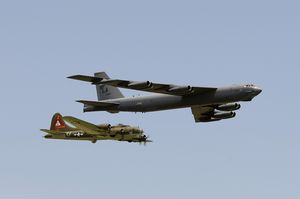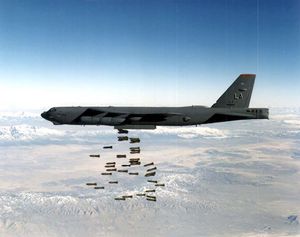B-52 Superfortress
A classic aircraft design still in service more than fifty years after the first version flew, the Boeing B-52 is a heavy bomber operated by the United States Air Force. The official "name" of Stratofortress has never been widely used; perhaps the most common name for it in the military is BUFF, an abbreviation for Big Ugly Fat Fellow[1]. The final model, B-52H, is expected to stay in active service until at least 2030. [2] The B-52 celebrated its 50th anniversary (first flight April 1952) in April 2002 and is the longest serving combat aircraft in the world - a total of 744 were built.
Bombers had advanced rapidly in the Second World War, with the Boeing B-17 the mainstay of the offensive against Germany, and the B-29 against Japan. Both with the coming need to carry large nuclear weapons and have intercontinental range, requirements for a followon were being defined even during the war. While the B-36 was an interim attempt, the B-52 became the first production all-jet heavy bomber with intercontinental range.
The B-52A first flew in 1954, and the B model entered service in 1955. A total of 744 B-52s were built with the last, a B-52H, delivered in October 1962. Only the H model is still in the Air Force inventory and is assigned to Air Combat Command and the Air Force Reserves.[3]
The first of 102 B-52H's was delivered to Strategic Air Command in May 1961. The H model can carry up to 20 air launched cruise missiles. In addition, it can carry the conventional cruise missile that was launched in several contingencies during the 1990s, starting with Iraq and ending in the Balkans.
The B-52H entered service in 1961 and 104 were built. The last was delivered in 1962. However, due to extensive system and structural upgrades, its service life is expected to continue beyond the year 2040.
Originally intended to fly high and fast to targets in the Soviet Union, improvements in the Soviet integrated air defense system made such a flight path suicidal, except when firing long-range air-to-surface missiles. In the nuclear delivery role, the aircraft was mechanically strengthened and given penetration flight paths at extremely low altitude.
Current missions
In its present uses, the B-52 flies at high altitude (up to 50,000 feet) and high subsonic speed, generally over areas where the air defenses are nonexistent or have been suppressed. It can B-52 can perform strike with standoff weapons, battlefield air interdiction, offensive counter-air against enemy air facilities, and deliver precision-guided munitions in close air support. While B-52s are counted as nuclear delivery systems under arms control treaties, that is not their principal role.
They are organized into two wings, one at Barksdale Air Force Base, Louisiana, and the other at Minot AFB, North Dakota. Barksdale AFB is also home to their controlling headquarters, the Eighth Air Force.
It can complement purpose-built maritime patrol aircraft such as the P-3 Orion, Vulcan MR.1, and P-8 Poseidon, and provide ocean surveillance, anti-shipping warfare, and lay naval mines. Two B-52s, in two hours, can monitor 140,000 square miles (364,000 square kilometers) of ocean surface.[3]
Special operations teams in Afghanistan routinely directed B-52 attacks, on nearby targets, by providing target coordinates for Joint Direct Action Munitions. This was informally described as having a "2,000 pound hand grenade" available, quickly, to small forces.
With JDAM, it is possible for a B-52 to strike numerous independent tactical targets in the same mission. The Small Diameter Bomb equipped with JDAM is part of that evolution; one does not need or want a 2,000 pound bomb if a 250 pound bomb can hit very near the target.
Historical operations
Cold War
Vietnam
With the exception of the 11-day Operation Linebacker II attacks against North Vietnam in 1972, the B-52 bombers, designed for strategic nuclear attacks on Soviet and Chinese targets, principally operated in a tactical support role of mass bombing in South Vietnam. Other than the Linebacker campaign, the strategic bombing campaign against North Vietnam was carried out by Air Force and Navy fighter-bombers, designed as tactical aircraft.[4] Under the code name of ARC LIGHT, B-52s flew missions over suspected enemy areas, each B-52 typically dropping 42,000 pounds of conventional explosives. They bombed from high altitude, out of sight and hearing, so the first warning of the actual attack would be exploding bombs. Poor U.S. communications security, as well as Soviet intelligence ships in international waters near the main base in Guam, would give a general warning that an attack was on the way, but not where.
Gulf War
During the 1991 Gulf War, B-52s delivered 40 percent of the tonnage of all weapons dropped, [3] although it should be understood that much of this tonnage consisted of "dumb" gravity bombs used against troops in the open. On a number of occasions, such area bombing was not aimed to hit Iraqi soldiers, but to as psychological warfare. [5] In contrast to the usual goal of achieving surprise in attack, the technique here, given that the Iraqi air defenses capable of hitting a B-52 were destroyed, was:
- on the day before the bombing, drop leaflets warning of the attack and giving instructions on how to surrender
- bomb
- On the next day, drop more leaflets essentially saying "we kept our word. Save your lives."
Flight systems
| System | Component |
|---|---|
| AN/ASQ-151 electro-optical viewing system (EVS) | AN/AAQ-6 Forward Looking Infrared (FLIR) |
| AN/ASQ-151 electro-optical viewing system (EVS) | AN/AVQ-22 low-light-level television camera (LLTV) |
Offensive armament
Avionics
| System | Component | Function |
|---|---|---|
| AN/ASQ-176 Offensive Avionics System (OAS) | Northrop Grumman strategic radar | |
| AN/ASQ-176 Offensive Avionics System (OAS) | Honeywell radar altimeter | |
| AN/ASQ-176 Offensive Avionics System (OAS) | Smiths attitude heading and reference system | |
| AN/ASQ-176 Offensive Avionics System (OAS) | TERCOM terrain contour mapping | |
| AN/ASQ-176 Offensive Avionics System (OAS) | AN/ASN-131 | inertial navigation system (to be replaced with AN/SNU-84 |
| AN/ASQ-176 Offensive Avionics System (OAS) | AN/ASQ-38 | bombing and navigation system |
Weapons
Current B-52H aircraft carry all munitions in the internal bomb bay, although other models have variously carried air-to-surface missiles, decoys, or racks for additional conventional bombs on the wings.
The B-52H, with a weapons payload of more than 70,000lb, is capable of carrying the most diverse range of nuclear and non-nuclear weapons of any combat aircraft.
| Weapon | Type | Quantity | Comments |
|---|---|---|---|
| B83 | gravity bomb with megaton-range yield | up to 8 | |
| B61 | gravity bomb of moderate yield, | up to 8 | one version with limited subsurface penetration |
| AGM-86A Air Launched Cruise Missile | standoff missile | up to 20 | up to 1500mi/2400 km range |
The conventional weapons payload is four AGM-142 Raptor missiles, 20 AGM-86C Conventional Air Launched Cruise Missiles (CALCM), 12 Joint Stand Off Weapons (JSOW), 12 Joint Direct Attack Munitions (JDAM) and 16 Wind-Corrected Munitions Dispenser (WCMD). WCMD was first deployed by the B-52 in 2002 in Afghanistan. JSOW entered service in 2003 and was deployed during Operation Iraqi Freedom.
| Weapon | Type | Quantity | Comments |
|---|---|---|---|
| Mk. 82 bomb | 500 pound high explosive | up to 51 | can be converted to JDAM |
| Mk. 83 bomb | 1000 pound high explosive | up to 30 | can be converted to JDAM |
| Mk. 84 bomb/JDAM | 2000 pound high explosive | up to 12 | usually configured as JDAM |
| AGM-84 Harpoon | anti-shipping missile | up to 8 | - |
| Small Diameter Bomb | Gravity bomb; can be guided | up to 32 | For minimum collateral damage |
| AGM-164 Joint Standoff Weapon | Conventional air-launched cruise missileanti-shipping missile | up to 12 | 1200 km (750 miles) range; AGM-86C blast-fragmentation, AGM-86D hard target |
| Wind-Corrected Munitions Dispenser | gliding, guided cluster bomb | up to 16 | |
| AGM-86 CALCM | Conventional air-launched cruise missile | up to 8 | 1200 km (750 miles) range; AGM-86C blast-fragmentation, AGM-86D hard target |
| Naval mine | up to 20 |
Defensive systems
While early B-52 aircraft were equipped with radar-controlled 20mm autocannon in the tail, all defensive equipment is now for electronic warfare, including defense against heat-seeking missiles.
| Designation | Description |
|---|---|
| AN/ALQ-172(V)2 | Radar detection and jamming |
| AN/ALR-20A | Radar detection and threat prioritization |
| AN/ALR-46 | Radar warning |
| AN/ALQ-155 | High power jammer |
| AN/ALQ-122 | Dece[tove jammer |
| AN/ALR-155 | High power jammer |
| AN/ALQ-122 | Tail-mounted radar warning |
| AN/ALR-155 | High power jammer |
| AN/ALE-20 | Infrared flare decoy dispenser |
| AN/ALE-24 | chaff dispenser for radar reflectors |
General characteristics
- Primary Function: Heavy bomber
- Contractor: Boeing Military Airplane Co.
- Power plant: Eight Pratt & Whitney engines TF33-P-3/103 turbofan
- Thrust: Each engine up to 17,000 pounds
- Wingspan: 185 feet (56.4 meters)
- Length: 159 feet, 4 inches (48.5 meters)
- Height: 40 feet, 8 inches (12.4 meters)
- Weight: Approximately 185,000 pounds (83,250 kilograms)
- Maximum Takeoff Weight: 488,000 pounds (219,600 kilograms)
- Fuel Capacity: 312,197 pounds
- Payload: 70,000 pounds (31,500 kilograms)
- Speed: 650 miles per hour (Mach 0.86)
- Range: 8,800 miles (7,652 nautical miles)
- Ceiling: 50,000 feet (15,151.5 meters)
- Armament: Approximately 70,000 pounds (31,500 kilograms) mixed ordnance -- bombs, mines and missiles. (Modified to carry air-launched cruise missiles)
- Crew: Five (aircraft commander, pilot, radar navigator, navigator and electronic warfare officer
- Unit Cost: $53.4 million (fiscal 98 constant dollars)
- Initial operating capability: April 1952
- Inventory: Active force, 85; ANG, 0; Reserve, 9
References
- ↑ "Fellow" is used with due regard to Citizendium's family-friendliness policy
- ↑ B-52H Stratofortress Long-Range Multi-Role Bomber, USA
- ↑ 3.0 3.1 3.2 Air Force Link, B-52 Stratofortress
- ↑ Goebel, Greg, [2.1 B-52 in Southeast Asia: ARC LIGHT]
- ↑ Schwarzkopf, H Norman, Jr. (1992), It Doesn't Take a Hero, Bantam

